Menu
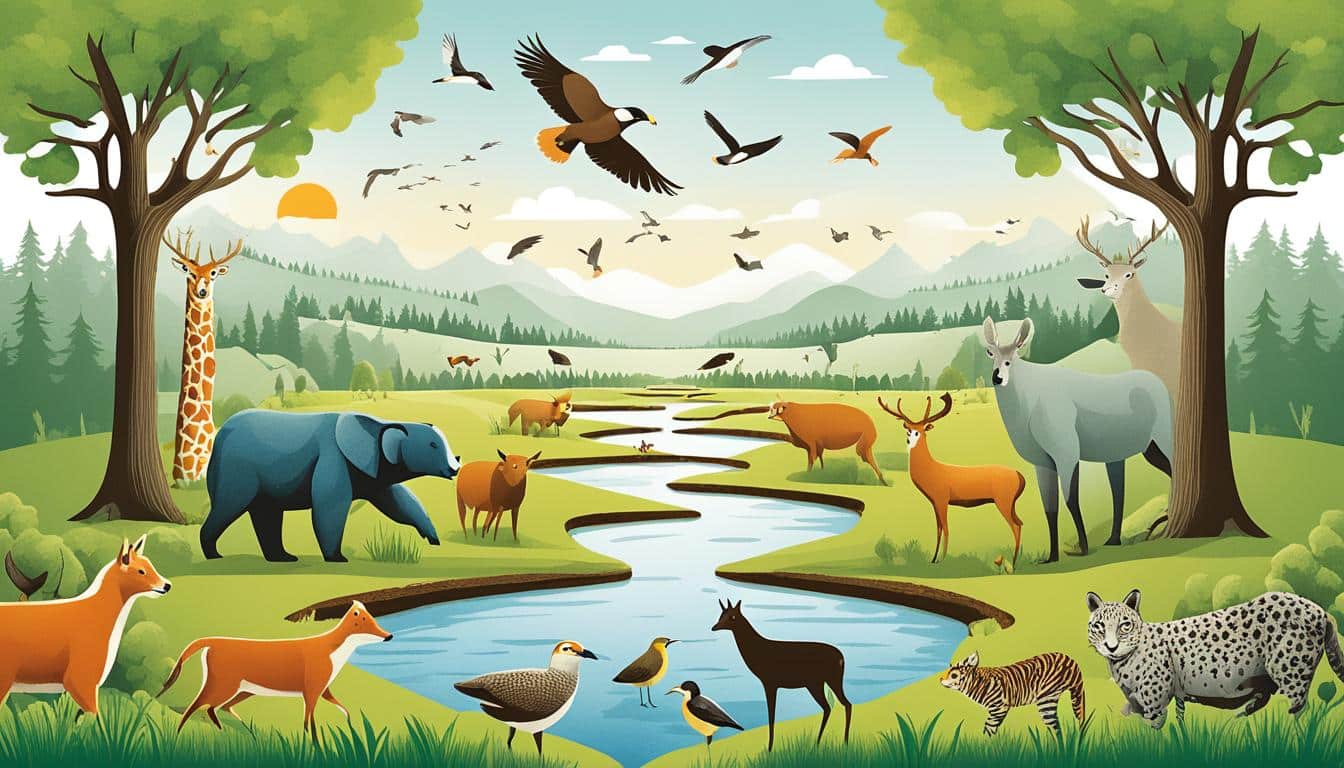
Did you know that 190 Faculty Law Review Articles look at animal welfare and environmental rules? This big number shows how important these issues are. It tells us that we are starting to care more about helping animals and saving nature.
This talk is about making us better by treating animals well. There’s a plan with three parts to fix the laws about animals and the environment. It means stopping bad laws, making good ones stronger, and creating a new way that puts nature first. This plan wants to slow down the damage we’re doing to the planet. It aims to protect animals because we need them to survive.
The bond between animal protection and environmental rules shapes how we care for nature. These rules work together to reduce our harm to animals and their homes. This shows us a positive path in safeguarding the wild.
Animal and environmental laws have grown beside each other. The Animal Welfare Act (AWA) of 1966, for example, set rules for animal care in different scenarios. It makes sure animals are treated well, watched over by the USDA’s Animal Care.
The AWA looks after animals, yet environmental laws go further. They work to protect entire ecosystems and their rich variety of life. This shows the bigger goals in wildlife protection.
The historical evolution of regulations reveals the critical need for a cohesive and interconnected regulatory approach that safeguards both animals and ecosystems.
The story of historical regulations recognizes a growing link between saving animals and nature. Laws ranging from the AWA’s changes in 1985 to broader Animal Welfare rules now root animals’ care in the big picture of environmental protection.
For example, officers check on animals during trips, showing how these laws overlap. This spotlights the shared goal of keeping animals safe and nature healthy.
Rules in animal travel insist on shortening trips to avoid harm and stress. Every five years, transport firms are checked to ensure they follow these caring rules. This supports both animals and environmental safety.
The International Air Transport Association’s guidelines and oversight like NSF Certification UK Ltd blend animal and environmental rules. This harmony is key to making laws that look out for both animals and nature.
| Aspect | Animal Law | Environmental Law |
|---|---|---|
| Focus | Welfare and humane treatment of animals | Protection of ecosystems and biodiversity |
| Key Legislation | Animal Welfare Act (AWA) | Endangered Species Act (ESA) |
| Regulatory Bodies | USDA, APHIS, Animal Care | EPA, Fish and Wildlife Service |
| Regulatory Examples | Transport regulations, laboratory standards | Environmental impact assessments, habitat preservation |
Grasping the connection between animal and environmental laws is key. This understanding leads to stronger, united actions that work for a better, kinder world for all.
The Animal Welfare Act (AWA) is a key legal point for animal care. It was made on August 24, 1966. This law shows how we protect animals’ rights and fight against cruelty.
It has grown through many changes, like the 1985 one that started the Animal Welfare Information Center. This shows how our laws for animals get better over time.

The AWA wants animals to be cared for well. This is needed everywhere, from labs and schools to shows and selling places. The USDA makes rules about this, according to 7 U.S.C. 2131.
The detailed rules are in the Code of Federal Regulations, specifically Animal Welfare 9 C.F.R. Parts 1, 2, and 3. These rules help make sure the AWA works well. Part 4 talks about what happens when people break these rules.
The Animal Welfare Act requires minimum standards of care and treatment for animals bred for commercial sale, used in research, teaching, testing, transported commercially, or exhibited to the public.
Yet, many challenges are growing, especially with wild animals kept in captivity. There aren’t enough laws on this from the country or the world. This can make the care of these animals poor.
Overall, setting strong rules, always making laws better, and accrediting well are key goals. They show real commitment to caring for animals and their protection.
Environmental policies play a key role in saving our planet. They create a strong legal framework of environmental law. This law helps protect our natural world which is facing huge threats to biodiversity.
Environmental law is vital for making policies that protect our environment. It looks at how livestock and meat production affect the environment. This covers things like animal health, labelling, and safe manure disposal.
The Agricultural Improvement Act of 2018 supports farmers with disaster aid. This includes programs like the Livestock Indemnity Program, helping to keep farmers afloat.
There’s more to it. The USDA and its Risk Management Agency help farmers with insurance against falling livestock prices. The Animal and Plant Health Inspection Service (APHIS) looks after disease control and health checks. The Environmental Protection Agency makes sure livestock farms follow strict rules on waste management.
Strong environmental policies greatly help keep biodiversity and ecosystems healthy. For example, the USDA’s inspection service checks that slaughterhouses are clean and safe. It focuses on avoiding food-borne diseases.
There are also rules on reporting prices and laws that the Department of Justice enforces. Together, these make the environmental legal system tougher.
Here’s a quick overview of the key roles different agencies play:
| Agency | Function |
|---|---|
| USDA Risk Management Agency | Insurance for cattle, swine, and lamb against price drops |
| Animal and Plant Health Inspection Service (APHIS) | Focuses on disease control, health checks, and emergency response |
| Environmental Protection Agency | Makes sure farms follow waste management regulations |
| Food Safety and Inspection Service | Inspect slaughterhouses and ensure food safety |
| Department of Justice | Enforces animal welfare laws through legal action |
All these rules and agencies help maintain a balance. By using laws and making sure they are followed, environmental policies protect the planet’s rich biodiversity and ecosystems.
Animal and environmental laws share common aims but face several hurdles. Often, their objectives conflict due to different focuses and strategies. The San Diego Zoo Global’s efforts in saving the Hawaiian birds show the common ground. But, the complex nature of this work is significant.
Since 1993, 800+ Hawaiian birds have been set free, linking bird preservation with nature’s protection. Yet, meeting these birds’ dietary needs in captivity is very hard. Different birds eat different things. If not met, they can become unhealthy and struggle to reproduce.
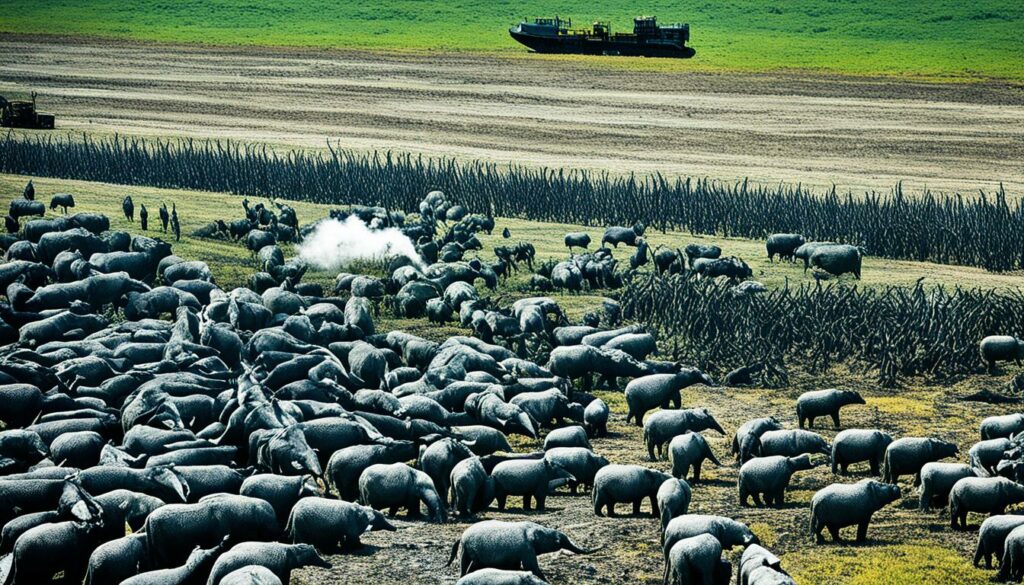
Also, ensuring birds have the right food in captivity is tough. It’s crucial for their health and breeding. Techniques like weighing their food are used. But, overall, the task is hard.
External factors like crop burning in Asia or domestic cats add to this complexity. These actions release a lot of CO2 and harm wildlife by hunting.
| Aspect | Environmental Goals | Animal Welfare Goals |
|---|---|---|
| Carbon Emissions | Reduce 379 million tonnes of CO2 from crop burning | Minimise impacts of animal agriculture on climate |
| Wildlife Conservation | Reforestation and habitat protection | Facilitate captive breeding programs for endangered species |
| Food Production | Sustainable land use and lower climate impact | Balanced diets and improved BCS for agricultural animals |
Addressing environmental and animal welfare challenges together is key. But, a minute number of studies do that. Only 24 out of 1,460 have tried. This highlights a big issue in combining these efforts.
Different pig farming methods illustrate these challenges. They each aim for different sustainability goals but face trade-offs. An approach may excel in one area but not in others.
New ways like cellular agriculture show promise. They could help join these efforts better. However, we need to check their impact on our sustainable aims more carefully. This is vital for both the animal and nature laws to work well.
The Endangered Species Act (ESA) started in 1973. It has been key in protecting animals and their homes. Many species, like the bald eagle and sea otters, have come back from almost vanishing because of it.
The ESA has strong rules to protect species and their lands. Different U.S. departments manage it based on the type of animal. It stops trade of endangered species. It also protects areas that are important for their survival.
This way, it helps stop things that could hurt these animals. And it makes sure the places they live in stay safe for them.
The ESA has many shining examples of success. For instance, the bald eagle’s numbers have jumped because of the ESA’s help. The gray wolf has also thrived in parts of the U.S. due to ESA’s efforts.
The California sea otter is another success. It’s slowly growing thanks to focus on keeping its habitat safe. These victories show how the ESA turns things around for animals in danger.
| Species | Status Before ESA | Current Status | Conservation Measures |
|---|---|---|---|
| Bald Eagle | Near extinction | Increasing population | Ban on DDT, habitat protection |
| Gray Wolf | Extirpated in most areas | Reintroduced and growing | Reintroduction programs, legal protection |
| California Sea Otter | Critically low numbers | Improving population | Marine habitat protection, legal safeguards |
The ESA also boosts tourism and farming in the U.S. Over 200 million visit National Parks each year. Protecting wildlife helps keep these jobs going. It shows how important nature is even in farming.
In the last ten years, ag-gag laws have become a big deal in the animal farming world. They have shown up in over half of the states across the U.S. Six states now have ag-gag laws in effect: Iowa, Utah, Missouri, Idaho, Wyoming, and North Carolina. But, courts have declared five other ag-gag laws unconstitutional.
These laws try to hide the harsh reality of life in factory farms. Yet, nearly everyone in the U.S. thinks animals in farms should be treated well and protected, even during undercover investigations. And most 64% of people don’t want to make these investigations illegal.
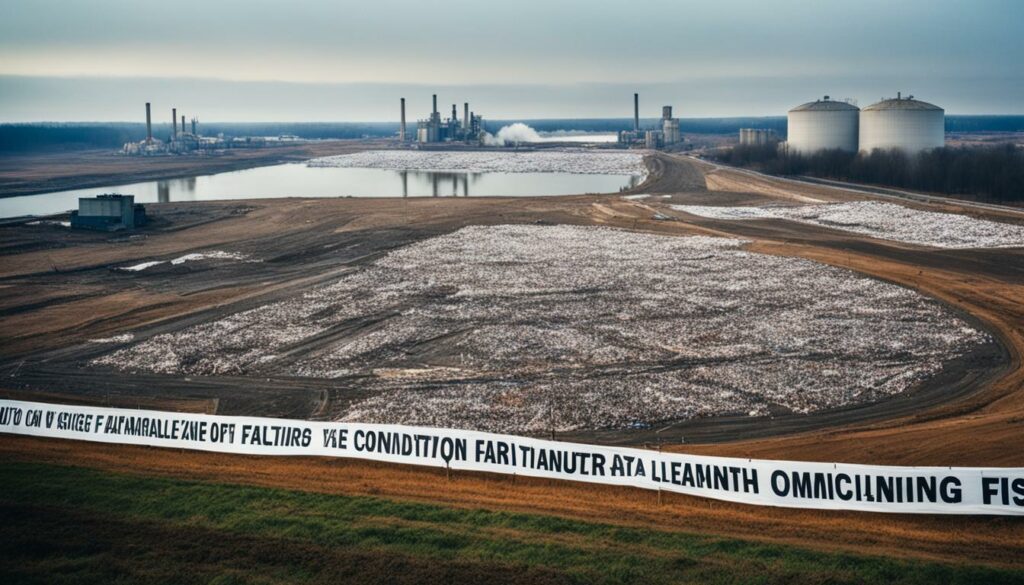
Investigations in factory farms have shown some disturbing things. For example, pregnant pigs and nursing pigs can be kept in very small crates. They also remove horns and animal tails without painkillers. Such practices have led to financial troubles for some farms. Some have even had to close because of what these investigations found.
Recent court cases suggest a growing opposition to ag-gag laws. In 2020, the U.S. District Court for the Southern District of Iowa stopped an ag-gag law from taking effect. The U.S. District Court for the District of Kansas also declared an important part of another law unfair. The case went to the 10th U.S. Circuit Court of Appeals, which agreed in 2021. And the U.S. Court of Appeals for the Fourth Circuit confirmed this in 2023 for North Carolina.
“The U.S. Court of Appeals for the Fourth Circuit ruled that undercover investigations and whistleblowing are considered protected newsgathering activities under the First Amendment.”
This table shows whether states have kept or scrapped their ag-gag laws:
| States | Ag-Gag Laws Passed | Ag-Gag Laws Struck Down |
|---|---|---|
| Iowa | Yes | Yes |
| Kansas | Yes | Yes |
| North Carolina | Yes | Yes |
| Idaho | Yes | Yes |
| Utah | Yes | Yes |
| Missouri | Yes | No |
| Wyoming | Yes | No |
In the end, while the debate on ag-gag laws isn’t over, courts are standing up for the right to expose wrongs in the farming industry. The debate on the impact of these laws on hiding animal abuse is far from settled. It’s a matter that deserves a lot of attention and careful thought from everyone involved.
In the world of law, who can speak for animals is a big question. It’s key for fighting for animal rights in court. This issue is hot when it comes to Acts like the Endangered Species Act (ESA).
https://www.youtube.com/watch?v=n7aMdDiMk4E
Figuring out who can go to court for animals is tricky. The Animal Welfare Act (AWA) lays down rules for looking after certain animals. But, some say it doesn’t let people stand up for these animals in court. This debate is crucial when dealing with harm under the AWA’s statute 7 U.S.C. 2131.
The need for research animals has led to problems with shady dealers. To tackle this, more rules and checks are in place, especially for Class B dealers. These dealers could be part of illegal pet trading. The AWA’s Section 7 makes it clear: research places can’t buy from dodgy dealers. This rule fights against animal misuse.
Updating laws and how courts deal with them is vital for helping animals and the environment. The Code of Federal Regulations offers strong advice. It also sets up a way to deal with AWA rule breakers.
For better animal rights in court, the USDA has set clear rules on what pain looks like for animals. This points to the need for change. Making the law clear helps courts protect animals better and stop cruelty.
| Key Legislation | Key Provisions |
|---|---|
| Animal Welfare Act (AWA) | Minimum care standards for animals in certain areas, and penalties for breaking the rules. |
| Code of Federal Regulations 9 C.F.R. Parts 1, 2, 3, and 4 | Has detailed rules for enforcing the AWA and running hearings on violations. |
| 7 U.S.C. 2131 | A law that makes clear rules on animal care and where they should come from. |
Taking an ecocentric approach is a big change for law. It’s about seeing that nature all over the world is in trouble. Legal changes are needed as our actions destroy the very systems we need to survive. Looking at how laws about animals and the environment connect shows us new ways to make laws.
An important article talks about joining animal and environmental laws. It says we must make our laws better to protect the earth and its creatures. This new way of looking at the law wants to get rid of bad laws and make stronger ones. It aims for laws that put the planet and its creatures first. For example, laws that hide bad things like hurting animals and the earth need to change or be stopped.

Also, talking about giving the environment rights under laws like the Endangered Species Act (ESA) is worth noting. It could change how we think about the relationships between people and nature. By giving rights to the environment and animals, these laws help push for big changes in how we see laws.
We need to see that animal and environmental laws, while slightly different, are very important. Groups that help animals and the environment work towards different but connected goals. Protecting all life and their homes is key.
By going the ecocentric route, we agree our laws should protect all living things and where they live. This approach is more than just changing laws; it’s about doing what’s right. It’s about the moral duty to care for our planet and everyone on it.
The spread of Concentrated Animal Feeding Operations (CAFOs) in the U.S. raises serious issues. These include worries about how animals are treated and the harm to our environment. Most of the meat and animal products Americans enjoy come from these big farms. This affects animals and the nature around them in big ways.
Factory farms keep nearly all farm animals in tight, unhealthy spaces. Back in 2009, more than 8.6 billion chickens and millions of pigs and cattle faced a sad end. These spaces hold too many animals, like over 125,000 chickens or 10,000 pigs in small areas. This cruel system also involves giving animals antibiotics to grow faster and stay healthy. But, this might make some diseases that can hurt people spread more easily.
The impact on our planet is huge too. The U.S. has almost 20,000 of these farms. From 2011 to 2017, over 1,400 more CAFOs joined the ranks. All these farms together put out a lot of methane gas, which is bad for our air and health. These animals also make a lot of waste, about a million tons, each day. This waste can get into our water and make us sick.
Living near these farms isn’t healthy either. The air pollution they create leads to more heart problems and can cause other health troubles. The way the big meat companies are set up makes things worse. Just four companies have a lot of power over what happens. This makes it even more important to change how these farms work and protect our environment better.
So, there’s a call for better ways of farming that think about animal care, the environment, and doing right by people. Facing these issues head-on will need everyone doing their part. Together, we can make a difference and create better ways to farm.
The European Commission has taken a big step with its new sustainability directive. This rule aims to connect three key areas: human rights, taking care of our planet, and looking after animals. The idea is for companies to check on their actions and also on what their suppliers do. This way, rights in farming are protected and animals are treated well.
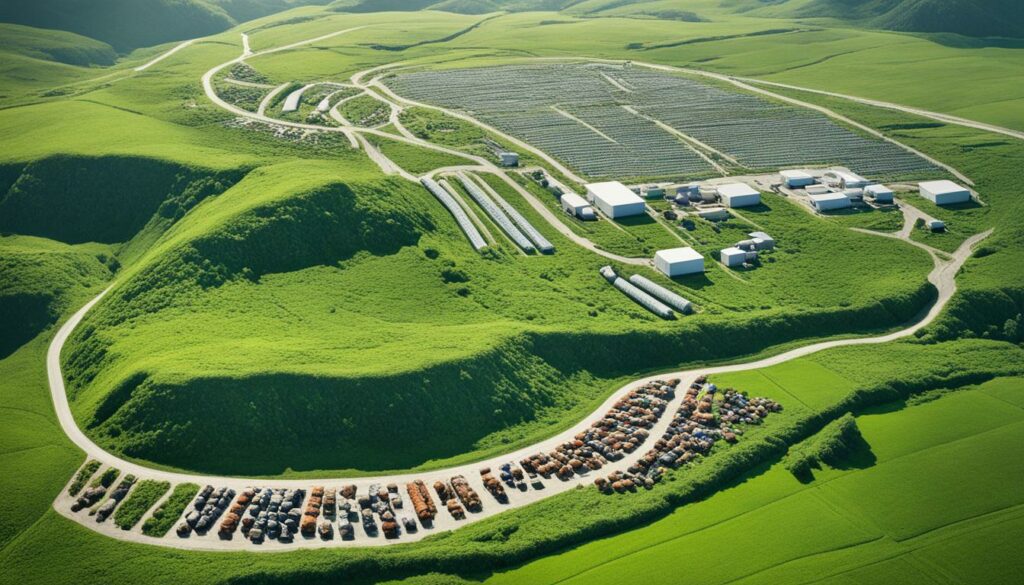
The new rule looks at responsibility in a full way. It tells companies to find, stop, and lessen any harm they do to people and the Earth. By doing this, it also pushes for better treatment of animals that are part of making products.
It’s important for companies to keep an eye on their supply chains. They need to make sure suppliers don’t use cruel practices, including in Canada and the U.S. Companies should make sure the ways animals are treated follow both moral and legal standards just like in the Animal Care Act (Manitoba).
| Directive Aspect | Objective | Impact |
|---|---|---|
| Human Rights | Protect workers’ rights | Improves working conditions |
| Environmental Stewardship | Minimize ecological footprint | Reduces environmental degradation |
| Animal Welfare | Ensure humane treatment | Eliminates cruel practices |
This new rule could change what shoppers look for and ask for stronger laws about animal care. By connecting human rights with how animals are treated, this rule points to a future. In this future, companies take more care leading to better and kinder ways of doing business everywhere.
Over the last century, the United States has worked hard to protect animals and wild places. Many laws and treaties now help keep animals safe and look after their homes. The U.S. Fish & Wildlife Service plays a big part in making sure these rules are followed.
Making rules to protect wildlife is a careful process. It involves making drafts, letting people see them, and then getting their thoughts before making them final. The FWS puts out these draft rules for public review in the Federal Register. They also share information in Congressional Testimonies. This all helps make the rules better and clearer.
The FWS is still very active in enforcing wildlife protection rules. They work to stop illegal hunting, like killing wolves or golden eagles, and stop the theft of cacti. Plus, they protect animal homes. They rely on the public’s help for information, sometimes offering rewards for tips that lead to catching the bad guys.
Laws are regularly updated to better look after species and their homes. One important law is the Endangered Species Act (ESA). This law, along with others, creates a solid plan for keeping both animals and their homes safe.
The Animal Welfare Act (AWA) from 1966 is focused on making sure animals are treated well. It covers places like zoos, labs, and where animals are bred. It says how animals should be cared for and kept. There are also laws to make slaughtering animals less painful, like the Humane Methods of Slaughter Act. The PACT Act, from 2019, makes extreme animal cruelty a federal crime.
States and towns have also made their own laws to protect animals. Sometimes, these local laws are even stricter than the national ones. For instance, some states ban selling pets in shops, and others forbid using elephants for shows. These local laws help look after animals better, setting an example for the whole country.
In closing, the US’s mix of wildlife and animal laws is key to saving nature and animals. With more laws and everyone helping, we can protect the wonderful animals and places on Earth.
In the United States, environmental sustainability laws are key to making the air and water healthier. Over the past fifty years, laws like the Clean Air Act and Clean Water Act have made a big difference. They show the U.S.’s promise to keep our natural areas safe and our people healthy. The Clean Air Act helps keep harmful chemicals away from us. And the Endangered Species Act looks after animals like the Kemp’s Ridley Sea Turtle. This type of support is why places such as Santa Cruz Island have seen such success in restoring their nature.
To help the environment, following eco-friendly rules is a must. The U.S. laws are all about using science to protect nature and make life healthier. These rules let different areas adjust to what they need, while still following the same national rules. Also, the government checks to make sure everyone is correctly obeying these rules. Money from both the national and state levels is very important to make sure these rules work as they should.
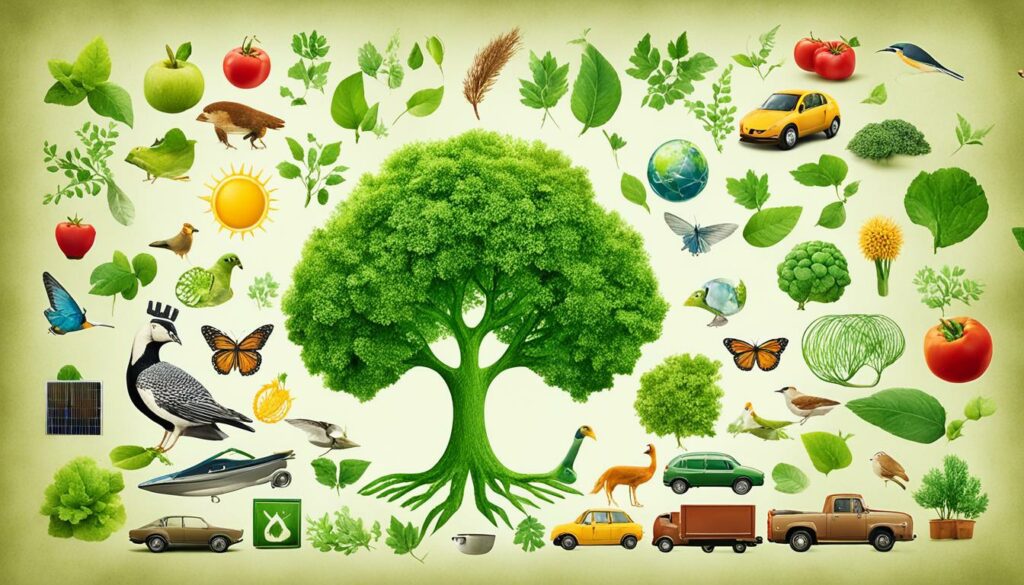
The U.S. has done well in its environmental laws, with many big wins. In 2021, the 9th U.S. Circuit Court alone made a big decision about the environment almost every week. But there are still big hurdles. Challenges like working together, quick decision making, and having enough money for enough checks slow down the full good use of these laws. It can also be hard for businesses to keep up with the costs of these rules. Some might choose to pay fines instead. It’s important to keep working to make sure these laws do the most good for our planet.
Advocacy for animal welfare and promoting environmental care are crucial efforts. They push for legal changes and a more caring society. This helps us treat the natural world with empathy and sustain it.
It’s shocking to know that trillions of animals are killed every year, mainly due to industries. This includes factory farming, deforestation, and the wildlife trade. This huge number shows why advocacy is urgent. Groups like the Humane League and Mercy for Animals are fighting to help these animals. They urge people to choose food that is produced ethically.
There’s been a big push to make people aware of environmental issues too. For example, New York City is cutting back on beef and processed meat, making a big impact. San Francisco’s hospitals have also joined in, reducing their meat use by 28%.
One area making a big difference is grown meat. It needs a lot less land and water than traditional meat. Plus, it creates fewer greenhouse gases. This could be key in saving our planet.
Many non-profits and groups are working to make things better. For instance, Faunalytics does research to help those fighting for animals. The Spokane Humane Society in Washington offers many services. They promote pet care and help animals find loving homes.
There are also efforts to change laws and show people the truth about some industries. This has already made a big impact, like reducing the use of fur and animal testing.
Everyone can play a part by supporting these groups. This can mean donating, volunteering, or simply choosing not to eat meat. Getting involved in government decisions is also key. Voting for politicians who care about animals makes a real difference.
| Organisation | Established | Mission |
|---|---|---|
| The Humane League | 2005 | Promote ethical choices to end farmed animal suffering |
| Mercy for Animals | 1999 | Prevent cruelty to farmed animals through compassionate food advocacy |
| Faunalytics | 2000 | Empower advocates with research to reduce animal suffering |
| Animal Haven | 1967 | Rescue and find homes for abandoned animals |
Humans have greatly affected our planet. Yet, we’re only a tiny part of all life. Recent studies show that we cause a lot of damage. Our actions have led to a mass extinction event. This is why strict rules for [biodiversity protection](https://link.springer.com/chapter/10.1007/978-3-662-60756-5_9) are so important.
Rules are needed to stop the loss of the Earth’s variety of life. Many species are in trouble. We need to make their living conditions better. Protecting animals is a key part of global efforts to save our biodiversity. It involves stopping suffering and making sure animals don’t go hungry or suffer.
Many studies show how caring for individual animals helps whole populations. International laws are starting to focus on animal welfare too. This is especially true in efforts to save endangered species. People are realising that good rules for biodiversity help both nature and us.
Interconnected approaches strengthen both animal welfare and environmental goals. They create bigger protections and push for a healthier balance between animal and eco health.
In the past, animal laws and green policies worked separately. But now, laws look to cover both their goals, showing the link between how animals and the environment are treated.
These laws focus on stopping cruelty towards animals. They make sure animals are treated well and give legal help to stop abuse. This is about recognising the rights of animals.
Green rules help keep different species and ecosystems safe. They aim to stop activities that harm the environment. This helps keep the balance of life on Earth.
One big problem is balancing animal care and protecting the environment. It’s hard to find where they agree. Creating joint policies is key to fighting issues.
The ESA is vital for saving animals and keeping nature in balance. It’s helped many species and areas recover. This law shows how strong eco laws can be.
“Ag-gag” laws stop people from learning about bad farm actions. They keep animal harm and environmental damage hidden. This makes it hard to improve farm and eco rules.
Only those directly affected can start cases about the environment and animal welfare. We need law changes to let more people sue, which can help these causes more often.
Ecocentric law looks to respect Earth and its creatures. It wants to change laws to include the value of nature. Doing this is key for fair treatment of all living things.
CAFOs badly affect animals, the environment, and people. They show why a caring and fair approach is needed in farming.
This Directive asks companies to consider rights and the environment in their work. It supports good business that is ethical and green.
These laws are key to keeping nature healthy and rich. They help save species and their homes, making sure nature stays strong.
Green laws set rules for activities that are safe for the Earth. They push for actions that help, not harm, the environment. This is key for a planet-safe future.
Pushing for change and making people aware is vital. A strong public voice can change laws and help care for animals and nature.
These rules aim to keep life’s variety alive. They are essential for human and nature’s well-being. They help all living things stay healthy and strong.